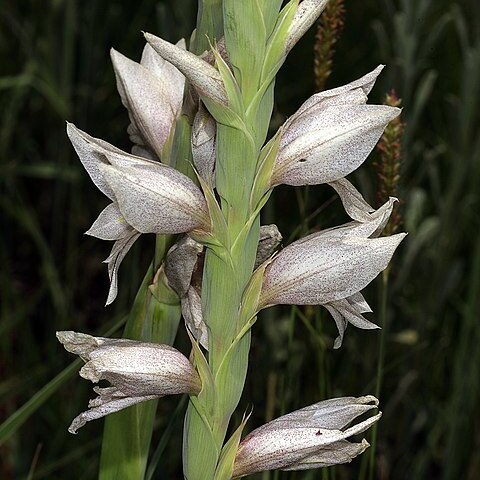Flowers white to pale-blue or purple, usually densely speckled with minute purple to pink dots, these more crowded towards the midline of the tepals, the lower tepals each with a central yellow streak in the lower half; perianth tube 15–16 mm long, shortly exserted from the bracts, narrowly funnel-shaped; tepals 25–33 mm long, lanceolate, the uppermost larger than the others and arching over the stamens, the lower 3 tepals united for 2–3 mm, narrower below, curving downward throughout, usually slightly exceeding the uppermost when viewed in profile.
Foliage leaves 3–4 basal, longer than the others, reaching at least to the base of the spike, rarely shortly exceeding it, 10–15 mm wide, narrowly lanceolate (to linear), sometimes minutely pubescent, the margins thickened and hyaline, the midrib less so and some other veins equally prominent; the upper leaves deceasing progressively in size, the uppermost sometimes entirely sheathing.
Cormous, glabrous geophyte, up to 0.8 m high; without hairs. Leaves in a compact fan, shorter than spikes, acute with many fine close-set similar nerves, without prominent midrib. Flowers: in a 14-20-flowered spike; bracteole with 2 long teeth; anthers > 12 mm long, mauve; perianth white, speckled with purple or rarely plain white; Nov.-May.
Spike erect, distichous, 9–15-flowered; bracts green or somewhat dry and light-brown above, 2–3 cm long, usually imbricate, often 1.5(2) internodes long, clasping the stem below, apices curved outwards, the inner about as long as the outer and bifid with acuminate-setaceous apices.
Cormous herb, up to 0.8 m high. Plants glabrous. Leaves in a compact fan, acute with many fine close-set similar nerves. Spikes up to 25-flowered. Bracteole with 2 long teeth. Flowers white, speckled with purple or rarely plain white.
Corms 2.0–2.5 cm in diameter; tunics membranous to coarsely fibrous.
Style dividing near the anther apices, style branches c. 5 mm long.
Filaments 8–10 mm long, exserted for 3–4 mm; anthers 8–11 mm long.
Capsules c. 2.5 cm long, nearly ellipsoid.
Stem erect, rarely branched.
Plants 35–80 cm high.

